 |
| Category: Flags |

|
|
|
|
|
| PPCLI;
Princess Patricia's Canadian Light Infantry |
| Princess
Patricia handcrafted and presented to the Regiment a Camp Colour to be
displayed wherever the Regiment was located. It was affectionately known
as the "Ric-A-Dam-Doo" ("Cloth
of Thy Mother" in Gaelic). |
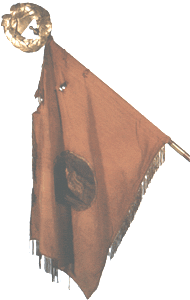  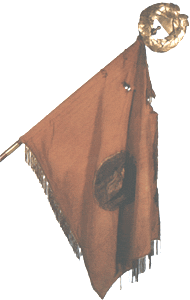 |

PPCLI stood alongside 3RAR
at Kapyong in Korea and both were awarded the Distinguished Unit
Citation, later renamed to the Presidential Unit Citation. The US Company
A, 72nd Heavy Tank Battalion were also decorated. |
| The Colours, historically
and symbolically, represent the heart and spirit of the Regiment. On the
Regimental Colour are carried the battle honours of the Regiment, which
recall past deeds and services. The Colours, emblazoned with distinctions
for gallant service create a feeling of pride and loyalty in the soldier
and most certainly in the hearts of all Patricias.
The Original Colour, The
Ric-a-Dam-Doo, was hand-made by Princess Patricia and presented to
the Regiment on the 23th of August, 1914. As it was a camp colour, it was
carried in action by the Regiment throughout the First World War. On 28
January 1919, it was formally consecrated and became the Regimental
Colour. |
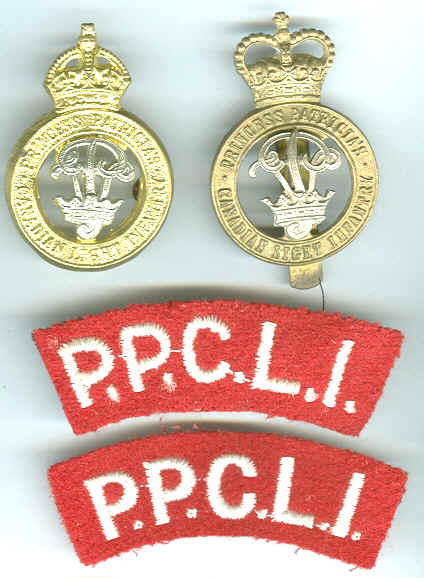 |
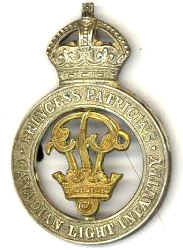 |
A replica of the Original
Colour and silk Union Jack as a King's Colour were presented in 1922 and
were laid up in 1934 in All Saint's Church, Winnipeg, when officially
approved Regimental and King's Colours were presented.
|
|
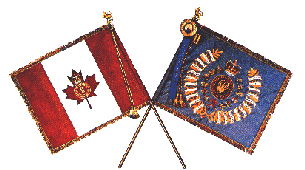
|
|
These new Colours, of which
the Regimental Colour bore ten battle honours from the First World War,
were carried by the Regiment and subsequently First Battalion until 1959,
when they were laid up in St. Paul's Church, Esquimalt.
Colours were first
presented to the Second Battalion in 1953 and new Colours were presented
to First Battalion in 1959.
These new Regimental Colours bore the
twenty-two major battle honours of both World Wars and Korea.
|
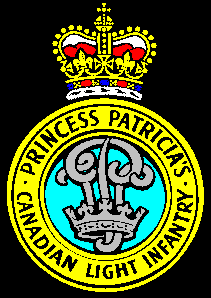 |
|
| Kapyong
The 2nd Battalion, Princess Patricia's Canadian Light Infantry, has a
unique distinction. This battalion received the Distinguished Unit
Citation from the President of the United States to recognize its stand
near Kapyong, Korea, in April 1951. Equating to a battle honour, the
Citation is represented by a streamer four feet in
length and two and three-quarter inches in width, bearing the name of the
action, attached to the pike of the regimental Colour (see above).
The use of this streamer in accordance with American practice was
authorized by King George VI. In addition to the streamer, the
Presidential Citation is also worn on the uniform. It is a small royal
blue bar with gold trim (see above). Although battle honours are awarded
on a regimental basis, and the whole of the PPCLI carries Kapyong on its
colours, the distinction of bearing this streamer belongs to 2 PPCLI alone
(in Canada), and is carried on the Battalion's Regimental Colour. The
badge is also unique, in the Canadian military, to 2PPCLI. |

|
 Distinguished Unit Citation
Distinguished Unit Citation
The Distinguished Unit
Citation was redesignated the Presidential Unit Citation (Army) 3
November 1966.
3d Battalion, Royal Australian
Regiment (23 and 24 April 1951) 2d Battalion,
Princess Patricia's Canadian Light Infantry (24 and 25 April 1951)
Company A, 72d Heavy Tank Battalion (United States) (24 and 25 April
1951)
The above units are cited for extraordinary heroism
and outstanding performance of combat duties in action against the armed
enemy near Kapyong, Korea, on the dates indicated. The enemy had broken
through the main line of resistance and penetrated to the area north of
Kapyong. The units listed above were deployed to stem the assault. The
3d Battalion, Royal Australian Regiment moved to the right flank of the
sector and took up defensive positions north of the Pukhon River. The 2d
Battalion, Princess Patricia's Canadian Light Infantry, defended in the
vicinity of Hill 677 on the left flank. Company A, 72d Heavy Tank
Battalion, supported all units to the full extent of its capacity and,
in addition, kept the main roads open and assisted in evacuating the
wounded. Troops from a retreating division passed through the sector
which enabled enemy troops to infiltrate with the withdrawing forces.
The enemy attacked savagely under the clangour of bugles and trumpets.
The forward elements were completely surrounded going through the first
day and into the second. Again and again the enemy threw waves of troops
at the outer defences, but each time the courageous, indomitable, and
determined soldiers repulsed the fanatical attacks. Ammunition ran low
and there was no time for food. Critical supplies were dropped by air to
the encircled troops, and they stood their ground in resolute defiance
of the enemy. With serene and indefatigable persistence, the gallant
soldiers held their defensive positions and took heavy toll of the
enemy. In some instances when the enemy penetrated the defences, the
commanders directed friendly artillery fire on their own positions in
repelling the thrusts. Toward the close of 25 April, the enemy
break-through had been stopped. The seriousness of the break-through on
the central front had been changed from defeat to victory by the gallant
stand of these heroic and courageous soldiers. The
3d Battalion, Royal Australian Regiment;
2d Battalion, Princess Patricia's Canadian Light
Infantry; and Company A, 72d Heavy Tank Battalion, displayed such
gallantry, determination, and esprit-de-corps in accomplishing their
missions under extremely difficult and hazardous conditions as to set
them apart and above other units participating in the campaign, and by
their achievements they brought distinguished credit on themselves,
their homelands, and all freedom loving nations. |
|
The Ric A Dam Doo
|
| "Princess Patricia,
after consenting to the use of her name by the Regiment, made a
"camp" color of her own design and which incorporated her
personal cipher. This color was presented to the Regiment on 23 August,
1914 at a parade in Landsdowne Park, Ottawa. On 28 January, 1919 it was
consecrated as the PPCLI Regimental Color. The Color is commonly
referred to as the RIC-A-DAM-DOO (gaelic for "cloth of thy
mother") and is now located in The Hall of Honor in the Regimental
Museum within the Museum of the Regiments in Calgary, Alberta, Canada.
At a farewell parade at Bramshot, England, on the 21 February, 1919
Princess Patricia decorated her Color with a wreath of laurel in silver
gilt (known as the "Wreath of Immortelles").
The Ric-A-Dam-Doo is a song
written about the PPCLI. All was written about the Regiment in
WW1.The song is about their Regimental Colours
(called "the Ric-A-Dam-Doo") which were actually handmade by
Princess Patricia of Connaught herself, granddaughter to Queen Victoria,
daughter of our (then) Governor General and Colonel-in-Chief of the
regiment. It regales the exploits of the Regiment since it's inception.
- The Princess Pat's Battalion
- They sailed across the Herring
Pond,
- They sailed across the Channel too,
- And landed there with the
Ric-A-Dam-Doo
- Dam-Doo, Dam-Doo.
-
- The Princess Pat's Battalion Scouts
- They never knew their whereabouts.
- If there's a pub within a mile or
two,
- You'll find them there with the
Ric-A-Dam-Doo,
- Dam-Doo, Dam-Doo.
-
- The Lewis Guns are always true
- To every call of the Ric-A-Dam-Doo.
- They're always there with a burst
or two
- Whenever they see the Ric-A-Dam-Doo,
- Dam-Doo, Dam-Doo.
-
- The Bombers of the Princess Pat's
- Are scared of naught, excepting
rats,
- They're full of pep and dynamite
too,
- They'd never lose the Ric-A-Dam-Doo,
- Dam-Doo, Dam-Doo.
-
- The Transport of the Princess Pat's
- Are all dressed up in Stetson hats.
- They shine their brass and limbers
too
- I believe they'd shine the
Ric-A-Dam-Doo,
- Dam-Doo, Dam-Doo.
-
- Old Number Three, our company
- We must fall in ten times a day.
- If we fell out 'twould never do
- For then we’d lose the
Ric-A-Dam-Doo,
- Dam-Doo, Dam-Doo.
-
- Old Charlie S., our Major dear,
- Who always buys us rum and beer,
- If there's a trench in a mile or
two
- You'll find him there with the
Ric-A-Dam-Doo,
- Dam-Doo, Dam-Doo.
-
- Old Ackity-Ack, our Colonel grand,
- The leader of this noble band,
- He'd go to Hell and charge right
through
- Before he'd lose the Ric-A-Dam-Doo,
- Dam-Doo, Dam-Doo.
-
- Old Hammy Gault, our first PP,
- He led this band across the sea,
- He'd lose an arm, or leg or two
- Before he'd lose the Ric-A-Dam-Doo,
- Dam-Doo, Dam-Doo.
-
- The Ric-A-Dam-Doo, pray what is
that?
- 'Twas made at home by Princess Pat,
- It's Red and Gold and Royal Blue,
- That's what we call the
Ric-A-Dam-Doo,
- Dam-Doo, Dam-Doo.
|
- The Herring Pond is the Atlantic Ocean
- The Channel is the English Channel
- Bombers are Grenade Throwers
- Scouts are used for reconnaissance and
information-gathering behind enemy lines
- A Lewis Gun is a light machine gun
- The Transport Troops wear Stetsons because the
wagons were horse-drawn in WWI
- Charlie S. is Major Charles Stewart who commanded
No 3 Company on 1916
- Ackity-Ack refers to Lieutenant-Colonel A.S.A.M.
Adamson, the regiment’s commanding officer during the Battle for
Vimy Ridge.
- Hammy Gault is Hamilton Gault of Montreal who
created the regiment, and equipped it at his own expense, for
overseas service during WWI.
|
|